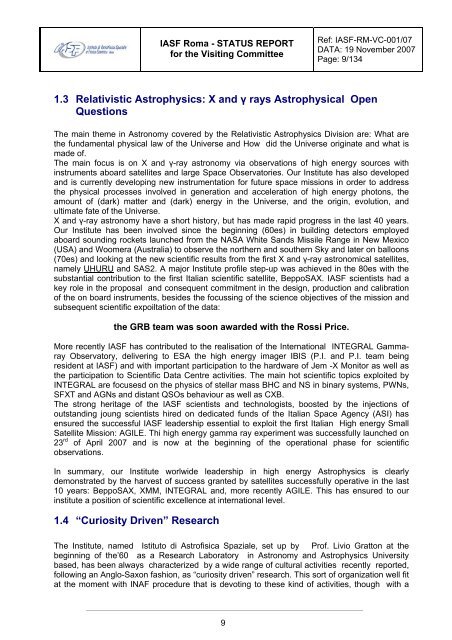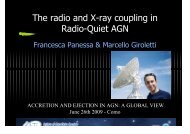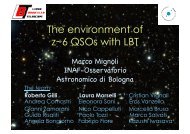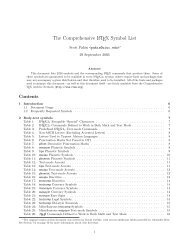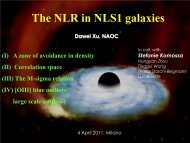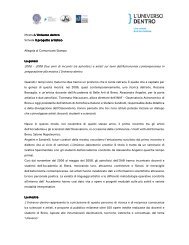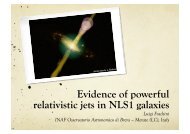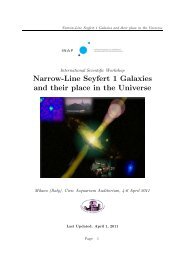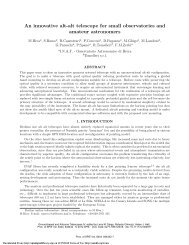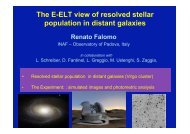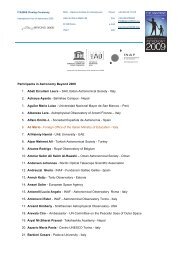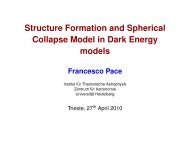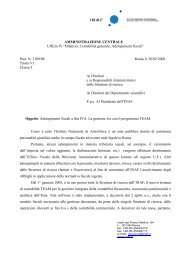<strong>IASF</strong> <strong>Roma</strong> - STATUS REPORTfor the Visiting CommitteeRef: <strong>IASF</strong>-RM-VC-001/07DATA: 19 November 2007Page: 8/134extrasolar planetary systems, an expanding field that will be the focus of major researches incoming years. The main branches of solar system research carried out at <strong>IASF</strong>-<strong>Roma</strong> are: thesmall bodies, i.e. comets, asteroids and transneptunian objects (TNOs); these bodies havebeen physically and chemically processed very little, compared to major planets, after theirformation in the protoplanetary nebula 4.5 Gyr ago, and are thus representative of the primitivesolar system materials. Particularly important in this context is the study of the impactphenomena related to Near Earth Objects (NEOs, i.e. asteroids and comets that can approachour planet), both dynamically and observationally; the terrestrial planets, Mercury, Venus,Earth (and Moon) and Mars; they provide clues to understanding the origin and evolution ofplanetary environments capable to support life, allowing us to extrapolate to the planetarysystems surrounding other stars. Mars is particularly interesting in this respect, since it couldhave developed some forms of life in the past; the giant planets; the study of their evolution isthe key to understand the global evolution of the solar system. The giant planets containalmost all the mass and of the angular momentum of the entire planetary system, and haveheavily influenced all the other members of that system; the satellites; the satellite systems ofthe giant planets are in fact miniature planetary systems, and the accretion mechanism that ledto the formation of the regular satellites is analogous to the one that led to the formation of theplanets. Io, Europa, Ganymede, Callisto, Titan and Triton are larger than Pluto, and two amongthem are larger than Mercury, so that they can be condidered as planetary bodies by all means.Titan, with its dense atmosphere rich in organic elements, and Europa, that could host in itsinterior an amount of liquid water larger than that of the Earth, represent environments in whichlife could have developed.These four great areas of research are tied to each other thhrough the modelling of the earlyphases of formation and evolution of the solar system, and to the dynamical interactions ofsmall bodies.1.2 Stars, Stellar Population and Interstellar Medium: Star Formationand EvolutionA proper understanding of our Universe requires a proper knowledge of the evolutionaryproperties of the stars. They are responsible, e.g., of the re ionization at Z=5-6, of its chemicalevolution, they can inhibit and/or trigger new star formation, they contribute to the dynamicalevolution of the galaxies and are also a continuous source of neutrinos. Their dynamics alsoreflects the average one of their host Galaxy. The determination of their age, of their chemicalcomposition and surface luminosity and radius constitutes a fundamental source of informationregarding the age of the Universe, the Big Bang Nucleosynthesis, the first phase of chemicalenrichment of the primordial gas and on the distance scale.In order to obtain such results, animproved modeling of the stars together to observational campaign with the latest generationtelescopes is mandatory. The knowledge of the processes that lead to the stellar formation issimilarly important because the influence of a star on the environment strongly depends on itsinitial mass and hence the impact of each stellar generation on the surrounding will depend onits intial mass function. Since stars form in cold giant molecular clouds, infrared and Xobservations play a pivotal role in this context, i.e. in the localization and study of the stars intheir first evolutionary phase the bridges the initial chaotic collapse of a gas cloud to thesettling of the star in the quiescent long lasting phase of central H burning.Also the astroseismology plays a relevant role since it allows the investigation of internalproperties of the stars (through the interpretation of the surface oscillation frequencies), like theinternal rotation, H content, magnetic fields, extension of the convective layers that would beotherwise unaccessible to a direct measure.8
<strong>IASF</strong> <strong>Roma</strong> - STATUS REPORTfor the Visiting CommitteeRef: <strong>IASF</strong>-RM-VC-001/07DATA: 19 November 2007Page: 9/1341.3 Relativistic Astrophysics: X and γ rays Astrophysical OpenQuestionsThe main theme in Astronomy covered by the Relativistic Astrophysics Division are: What arethe fundamental physical law of the Universe and How did the Universe originate and what ismade of.The main focus is on X and γ-ray astronomy via observations of high energy sources withinstruments aboard satellites and large Space Observatories. Our Institute has also developedand is currently developing new instrumentation for future space missions in order to addressthe physical processes involved in generation and acceleration of high energy photons, theamount of (dark) matter and (dark) energy in the Universe, and the origin, evolution, andultimate fate of the Universe.X and γ-ray astronomy have a short history, but has made rapid progress in the last 40 years.Our Institute has been involved since the beginning (60es) in building detectors employedaboard sounding rockets launched from the NASA White Sands Missile Range in New Mexico(USA) and Woomera (Australia) to observe the northern and southern Sky and later on balloons(70es) and looking at the new scientific results from the first X and γ-ray astronomical satellites,namely UHURU and SAS2. A major Institute profile step-up was achieved in the 80es with thesubstantial contribution to the first Italian scientific satellite, BeppoSAX. <strong>IASF</strong> scientists had akey role in the proposal and consequent commitment in the design, production and calibrationof the on board instruments, besides the focussing of the science objectives of the mission andsubsequent scientific expoiltation of the data:the GRB team was soon awarded with the Rossi Price.More recently <strong>IASF</strong> has contributed to the realisation of the International INTEGRAL GammarayObservatory, delivering to ESA the high energy imager IBIS (P.I. and P.I. team beingresident at <strong>IASF</strong>) and with important participation to the hardware of Jem -X Monitor as well asthe participation to Scientific Data Centre activities. The main hot scientific topics exploited byINTEGRAL are focusesd on the physics of stellar mass BHC and NS in binary systems, PWNs,SFXT and AGNs and distant QSOs behaviour as well as CXB.The strong heritage of the <strong>IASF</strong> scientists and technologists, boosted by the injections ofoutstanding joung scientists hired on dedicated funds of the Italian Space Agency (ASI) hasensured the successful <strong>IASF</strong> leadership essential to exploit the first Italian High energy SmallSatellite Mission: AGILE. Thi high energy gamma ray experiment was successfully launched on23 rd of April 2007 and is now at the beginning of the operational phase for scientificobservations.In summary, our Institute worlwide leadership in high energy Astrophysics is clearlydemonstrated by the harvest of success granted by satellites successfully operative in the last10 years: BeppoSAX, XMM, INTEGRAL and, more recently AGILE. This has ensured to ourinstitute a position of scientific excellence at international level.1.4 “Curiosity Driven” ResearchThe Institute, named Istituto di Astrofisica Spaziale, set up by Prof. Livio Gratton at thebeginning of the’60 as a Research Laboratory in Astronomy and Astrophysics Universitybased, has been always characterized by a wide range of cultural activities recently reported,following an Anglo-Saxon fashion, as “curiosity driven” research. This sort of organization well fitat the moment with <strong>INAF</strong> procedure that is devoting to these kind of activities, though with a9


